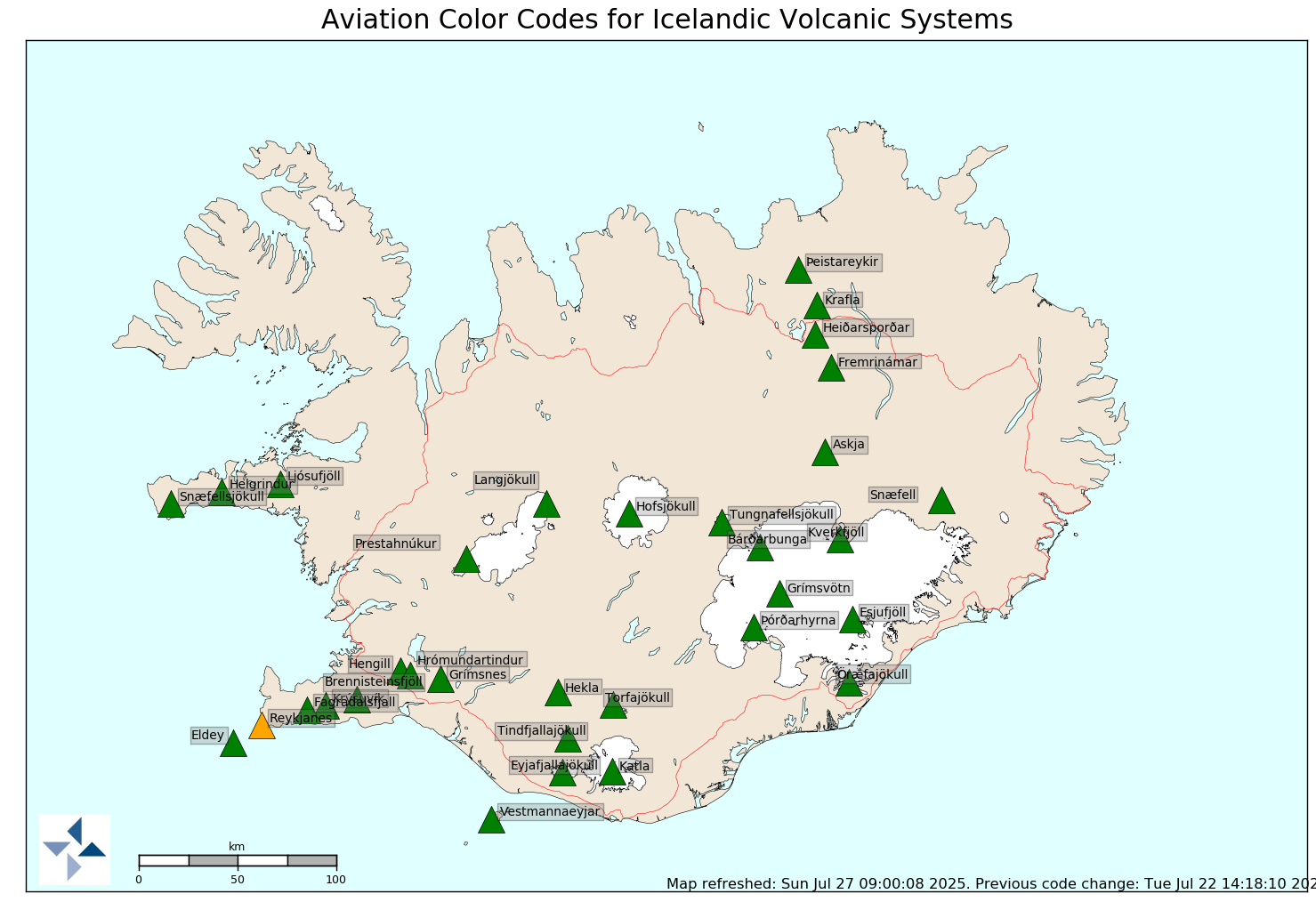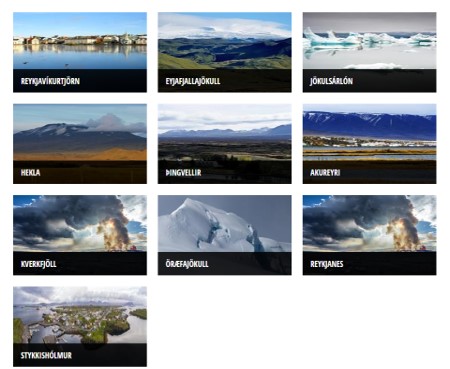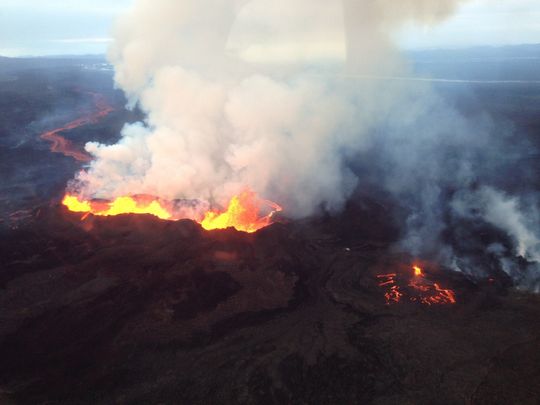Icelandic Volcanos
Aviation colour code map |
Webcams |
|---|---|

Click for enlarged aviation colour code map |
 Web cameras from Mķla |
| Icelandic Meteorological office - News |
|---|
Icelandic Meteorological office |
| April 15th, 2025 12:12:00 EDT -0400 Uplift continues beneath Svartsengi Uplift at Svartsengi continues, though the rate has slowed compared to last week. The current rate is about twice as fast as it was just before the last eruption, and is similar to the rate observed at the start of the current eruption cycle that began in 2024. |
| April 8th, 2025 04:06:00 EDT -0400 Uplift continues beneath
Svartsengi Updated April 8, at 16:15 UTC Deformation measurements clearly show that uplift beneath Svartsengi is ongoing. The current uplift rate is faster than that observed following previous eruptions. This may be explained by the large volume of magma ā around 30 million cubic meters ā that was released from the system during the most recent event. However, it is still too early to predict how the rate of magma accumulation will develop. Past events have shown that accumulation rates typically decline as more time passes between eruptions. At least a week, and possibly several weeks, will need to pass before we can evaluate if ā and how ā the rate of accumulation will change. |
| March 25th, 2025 13:30:00 EDT -0400 Eruption at the SundhnĆŗkur crater row remains likely Updated 25. March at 15:00 UTC GPS deformation data shows that magma continues to accumulate beneath Svartsengi, although the pace of land uplift has slightly decreased in recent weeks. Despite the slower uplift, experts still consider it likely that a magma intrusion and/or eruption will occur along the SundhnĆŗkur crater row. |
| March 13th, 2025 10:43:00 EDT -0400 Earthquake swarm ongoing
offshore ReykjanestĆ” At around 14:30 yesterday (12 March 2025), a rather intense earthquake swarm began offshore ReykjanestĆ”. The swarm was most intense at the beginning when about 50 ā 60 earthquakes were recorded in the first few hours. As the day progressed, the activity decreased but then increased again shortly before midnight when an earthquake of magnitude 3.5 occurred. When the activity increased again in the evening, it shifted slightly westward as the image shows (blue circles indicate the location of earthquakes that occurred at the beginning of the swarm yesterday, while yellow and red ones show earthquakes from late last evening and night). |
| February 5th, 2025 08:34:00 EST -0500 The weather in Iceland in 2024 The year 2024 was remarkably cold compared to temperatures of this century. The national average temperature was 0.8 degrees below the 1991 to 2020 mean, and it was the coldest year since 1998. Lowest relative temperature was inland in the North, while it was warmer along the southern coast. The summer was wet across the entire country, but other months of the year were relatively dry. Overall, the year was drier than average in the eastern, southern, and southwestern parts of the country, but wetter than average in the North and West, which experienced heavy rain during summer. The sea level pressure was unusually low from June through August, and the summer was characterized by frequent low-pressure system passage and unfavourable weather. During other seasons, the weather was relatively calm, and annual mean seal level pressure and wind speed were around average. |
| February 5th, 2025 09:27:00 EST -0500 Red weather warnings in effect today ā no travel
recommended A southerly storm or violent storm is expected later today and tomorrow, with very strong wind gusts, widely 35 ā 45 m/s and especially near mountains, but locally exceeding 50 m/s. Considerable or heavy rain is expected in the south and the west regions of the country. More details can be found here. |
| February 3rd, 2025 10:02:00 EST -0500 New weather forecast website launched The first phase of the Icelandic Meteorological Office's (IMO) new website was launched today. This marks the beginning of a major project aimed at renewing both the website and its entire technical infrastructure. The new weather forecast website is available at https://gottvedur.is/en/. While the site is still in development, once the renewal of the current website is complete, the new weather pages will be moved to the domain vedur.is. |
| January 17th, 2025 09:37:00 EST -0500 Earthquakes
continue to be recorded at great depths near GrjĆ³tĆ”rvatn Updated 17. January 14:00 UTC Seismic activity continues to increase near GrjĆ³tĆ”rvatn. So far in January, nearly 100 earthquakes above M1.0 have been recorded. This is comparable to the total number of earthquakes in December 2024, which was the highest monthly count ever recorded in the area. |
| January 14th, 2025 09:48:00 EST -0500 Strong
earthquake swarm in BƔrưarbunga. Largest earthquake magnitude 5.1 A strong earthquake swarm began shortly after 6:00 UTC today in the
northwestern part of the BƔrưarbunga caldera. Approximately 130 earthquakes
have been recorded since the swarm began, with the largest reaching magnitude
5.1 at 8:05 UTC. Additionally, 17 other earthquakes with a magnitude of 3 or higher were detected, including at least two measuring magnitude 4 or above. These estimates may change as analysis of the events is ongoing. |
| January 13th, 2025 08:26:00 EST -0500 Glacial outburst flood
from GrĆmsvƶtn likely in progress In recent days, a gradual increase in seismic tremor has been recorded on the GrĆmsfjall seismometer, suggesting that a glacial outburst flood has begun from GrĆmsvƶtn. These floods emerge from the base of SkeiĆ°arĆ”rjƶkull glacier, flowing into the GĆgjukvĆsl river. Typically, these glacial outburst floods increase gradually, and it can take a few days for the first signs of floodwater to be detected at the hydrological station in GĆgjukvĆsl river and an additional few days before peak discharge is reached. With precipitation in southeast Iceland in the past days, and more expected in the coming days, the identification of the initial signs of the flood In GĆgjukvĆsl could prove to be challenging. |
| December 19th, 2024 09:57:00 EST -0500 Ground uplift under Svartsengi area continues at a stable rate Updated 19 December 17:00 UTC A photogrammetric survey was conducted by Icelandic Institute of Natural History and LandmƦlingar Ćslands in a flight over the eruption site 13 December. The data reveals that the lava field that was formed during the last eruption (20 November to 9 December) had a total volume of 49,3 million cubic meters erupted and covered an area of 9,0 square kilometers. The thickest part of the lava field was around the craters and close to the barriers by the Blue Lagoon but the average thickness of the lava was 5,5 meters. |
| November 19th, 2024 18:15:00 EST -0500 Ground Uplift and Magma Accumulation Continue Beneath Svartsengi Updated 19. November at 14:45 UTC Seismic activity in the SundhnĆŗkar crater row remains relatively low. A few earthquakes have been recorded daily, most of them located between StĆ³ra-SkĆ³gfell and SĆ½lingarfell. On some days in the past week, bad weather has affected the sensitivity of the seismic monitoring system, potentially obstructing the detection of the smallest earthquakes. |
Could Bįršarbunga erupt in the near future. On August 16 and August 17, Icelandic scientists detected a pair of earthquake swarms in and around the volcano.
The area north of Vatnajokull glacier has been closed, and a widespread evacuation order is in effect, in the wake of ongoing earthquake activity around the subglacial volcano Bardarbunga, which is located in the northwestern part of the glacier.
There is currently no immediate danger, but if the volcano erupts, a major flood is expected to the north, fed by melting ice from the glacier.
London Volcanic Ash Advisory Centre VAAC
The London VAAC is an International Civil Aviation Organization (ICAO) designated centre, responsible for issuing advisories for volcanic eruptions originating in Iceland and the north-eastern corner of the North Atlantic.
Updates
3/10/2014 15:00 Filming an active volcano, using a DJI Phantom Quadcopter 2 drone. See the full video: here22/9/2014 9:30 This will be the last update unless activity increases
Seismic activity has been persistent, but at comparably low levels during the last hours. Since midnight around 10 earthquakes have been automatically detected on the caldera rim of Bįršarbunga. Another around 10 earthquakes were detected in the northern part of the dyke intrusion, all smaller than magnitude 2. Yesterday (21 September), between 19:00 and 24:00, 25 earthquakes were measured: 8 at Bįršarbunga, 13 at the northern end of the dyke and 2 at Heršubreiš. Earthquakes over M3.0 at Baršarbunga between19:00 21 September and 06:00 22 September:
at 19:51 M3,5
at 20:07 M3,7
at 23:08 M3,5
at 00:19 M3.6
at 03:13 M3.7
at 05:28 M3.5
The volcanic activity at the eruption site appears to be stable, based on webcam observations this morning.
21/9/2014 9:30
Last evening (19:00-24:00) about 30 earthquakes were detected, 10 at Bįršarbunga, 10 at the northern end of the intrusion and 5 at Heršubreiš and Heršubreišartögl (Töglin). The largest one was at Bįršarbunga at 22:46 3.9 and five more in the same area were over 3 in size.
From midnight til morning (24:00-07:00), automatically detected events are also around 30, most of them around northwestern Vatnajökull. The four largest events were all in northern part of Bįršarbunga caldera:
at 00:57 magnitude 4.8
at 02:21 magnitude 3.8
at 03:05 magnitude 3.7
at 03:30 magnitude 3.4
No visible changes in eruption at Holuhraun from webcams.
20/9/2014 9:40
Around 30 earthquakes have been automatically detected around northwestern Vatnajökull since midnight. Of these, around 10 were located on the Bįršarbunga caldera rim and another 15 in the northern end of the dyke intrusion. The strongest event was a magnitude 5.1 on the north-eastern caldera rim at 01:10.
19/9/2014 9:40
Since 19h yesterday evening only about 10 earthquakes were recorded at the Bardarbunga caldera and only 3 from midnight until 06:00 this morning. One, with magnitude 4.5 occurred at the northern rim of the caldera at 21:43. Two other earthquakes with magnitude over 3 occurred there at 23:44 and 01:57. At 06:44 this morning an earthquake of magnitude 4.7 occurred at the northeastern rim of the Bardarbunga caldera.
18/9/2014 10:45
The largest earthquakes recorded in Bardarbunga since 19:00 yesterday. A magnitude 3.2 earthquake occurred at 22:28, M4.1 earthquake at 22:52 , M3.5 at 23:35, M4.5, at 03:17 and M3.4 at 06:05. From midnight 13 earthquakes have been detected in Bįršarbunga, about 27 in the northern part of the dyke and around 20 by Heršubreiš and Heršubreišartögl, all below magnitude 2.
17/9/2014 10:00
The largest earthquakes recorded in Bįršarbunga since 19h yesterday occurred in the evening. A magnitude 4.8 earthquake occurred at 20:20 and a 5.4 earthquake at 21:34. From midnight 40 earthquakes have been recorded: 5 in Bįršarbunga, about 15 in the northern part of the dyke and around 20 by Heršubreiš and Heršubreišartögl, all below magnitude 2.
16/9/2014 22:50
Nearly 100 earthquakes have occurred since midnight. Just over 20 at Bįršarbunga and over 30 in the intrusion under Dyngjujökull and near the eruptive site. Earthquakes at the northern rim of Bįršarbunga caldera today were at 09:13 M3,4 and at 10:36 M4,8 and at 16:13 M3,7. At the southwestern rim there was an earthquake at 14:47 M5,2

The eruption site in Holuhraun at 18:40 today, 16 September 2014. Photo: Freysteinn Sigmundsson.
15/9/2014 09:00
No major changes are observed in the seismicity. 23 events were measured near Bįršarbunga and the dyke, of these nine occurred in Bįršarbunga. This rate is similar as two nights ago. The largest events were of magnitude M3.6 at 00:11 and M3.7 at 00:14 at the southern rim. Another one occurred at 02:27, M3.4 (size not confirmed yet) at the western rim. Swarms at Heršubreiš, Heršubreišartögl and Dreki continue (around 15 events in these areas in total). Eruption continues at Holuhraun.
14/9/2014 11:00
No major events have occurred since midnight, the largest events were at 01:47 M 3.5 and at 06:54 M 4.0 at the south- and southeastern rim of Bįršarbunga. According to webcam the eruption in Holuhraun still continues on one central crater (Baugur). The vertical displacement of the GPS-instrument on the ice-shelf at Bįršarbunga is around -20 cm from midnight.
13/9/2014 10:00
Since midnight, around 20 earthquakes have been recorded in the north-west region of Vatnajökull. Earthquake locations are similar to recent days: in Bįršarbunga, in the dyke intrusion near to the edge of Dyngjujökull, and occasionally at Heršubreišartögl.
12/9/2014 10:00
Thirty earthquakes have been recorded, mostly located in the dyke under Dyngjujökull and at the eruption site, and at the northern rim of Bįršarbunga. The largest earthquakes are around magnitude 2. A few earthquakes have occurred by Askja, Heršubreišartögl and Tungnafellsjökull.
11/9/2014 09:05
Earthquake activity is continuing in Bįršarbunga and in the northern part of the dike intrusion. The largest events occurred just after midnight (00:07:38, M5.3) at the southern caldera rim of Bįršarbunga and around five o'clock (05:00:38 of M4.3 and 05:04:49 of M3,0) at the northern rim of Bįršarbunga. Eruption is still ongoing.
10/9/2014 10:00
Earthquake activity is continuing in Bįršarbunga and in the northern part of the dike intrusion. Fewer events were detected at Heršubreišartögl. Eruption continues north of Dyngjujökull.
09/9/2014 22:30
Since this morning, 230 earthquakes have been recorded. The main activity has been in the northern part of the dyke, north of Heršubreiš, by Heršubreišartögl and at the rim of Bįršarbunga. No earthquakes larger than magnitude 3 have been recorded since 01:07.
08/9/2014 13:30
The earthquake activity today continues at the northern part of the dyke intrusion. The largest earthquake in the dyke since the end of August occurred at 16:27 today with magnitude 4.5. An earthquake swarm is taking place north of Heršubreiš. About 80 earthquakes have been recorded so far today
The earthquake activity since midnight continues at the northern part of the dyke intrusions and at Bįršarbunga. Between 30 and 40 events have been located in the area since midnight.
07/9/2014 18:30
The lava tongue now extends 11 km to the north and has reached the western main branch of Jökulsį į Fjöllum river.
Earthquake activity continues in Bįršarbunga, in the northern part of the dike intrusion and in Heršubreišartögl. Total of 70 earthquakes have been detected since midnight, the largest M5,7 at 07:08 in the Bįršarbunga caldera. The lava has reached Jökulsį į Fjöllum. Steaming occurs.
06/9/2014 15:25
The surveillance flight yesterday the ice-surface at Bįršarbunga was measured with the radar system of Isavia's aircraft. The measurements show large changes on the ice-surface. Up to 15 m subsidence has occurred in the centre of the caldera, which corresponds to a volume change of 0.25 km³. The shape of the subsidence area is in accordance with the elevation of the caldera floor having lowered by that amount. The most probable explanation is that this subsidence is related to the recent high seismic activity and subsurface magma flow to the northeast.
Earthquakes have been recorded in similar locations as in recent days: in Bįršarbunga, in the dyke intrusion beneath and north of Dyngjujökull and occasionally at Heršubreišartögl. At 05:40, an earthquake of magnitude 5 occurred on the rim of the Bįršarbunga caldera. Since midnight, the total number of automatically located earthquakes is around 50
05/9/2014 09:20
Two earthquakes of magnitude 4.3 and 5.2 occurred on the rim of the Bįršarbunga caldera. The first earthquake was recorded at 23:33 yesterday and the larger event at 01:19.
Toxic gases from the Holuhraun eruption have been measured up to six kilometers (four miles) high. Mostly it contains sulfur dioxide and scientists found some poisoning effect in the first day of the eruption. Up to now forty million cubic meters (1.200 million cubic feet) of lava have come out of the craters in Holuhraun.
04/9/2014 07:00
Since August 16th, 13 earthquakes have measured over 5 in magnitude.
03/9/2014 12:00
Seismic activity continued at similar rate as yesterday until 03:09 when M5.5 earthquake was measured in northern part of Bardarbunga. After that there was increase in activity both in the area under the northern part of Dyngjujokull, south of the current eruption site as well as in Herdubreidartogl. The Aviation Colour Code for Bįršarbunga remains at orange' and the code for Askja at yellow'.
02/9/2014 12:00
A noticeable decrease in seismicity has occurred during the last 24 hours. The level of activity is approximately half of that during recent days.
Volcanic activity in Holuhraun continues at steady rate. According to webcam observation there is no visible change in activity since yesterday with effusive lava eruption and fountains.
01/9/2014 19:00
Since midnight over 700 earthquakes have been detected automatically which is somewhat fewer than in the past few days. The main activity is in the dyke. Two earthquakes occurred by the northern rim of the Bardarbunga caldera, at 08:58 AM M5.0 and 11:41 AM M5.3. Over 140 earthquakes were detected by Heršubreišartögl, NE of Askja volcano. A few earthquakes were detected near Askja.
31/8/2014
31/8/2014 The new eruption in Holuhraun at 07:15. Video: Benedikt G. Ófeigsson.
The Aviation Colour Code for Bįršarbunga was raised at red' this morning and it has been moved back to 'orange' since 15:00 UTC. The color code for Askja is at yellow'.30/8/2014 Around 450 earthquakes have been detected since midnight 29/30 August until 07:00, the vast majority in the northern part of the dike intrusion Several events have been detected on the caldera rim of Bįršarbunga, strongest were M4.5 at 02:35 and M4.2 at 06:18, both on the northern rim. A magnitude M5.4 earthquake occurred at 07:03 at the southern rim of Bįršarbunga caldera. Several events of similar size have occurred around the caldera rim in recent days.
Summarizing, no significant changes in seismic activity have been observed.
Update
Icelandic authorities briefly raised the aviation warning code to red Friday after a small fissure eruption near Bardarbunga volcano, but no volcanic ash was detected by the radar system.
29/8/2014
Earthquake activity is high
At 11:14:59 AM (29 August) an earthquake of M4.8 occurred by the northern rim og the Bardarbunga caldera.
And yesterday
| Size | Time | Location |
|---|---|---|
| 5.0 | 28 Aug 08:13:40 | 7.3 km ENE of Bįršarbunga |
| 4.8 | 29 Aug 11:14:59 | 4.9 km NE of Bįršarbunga |
| 4.1 | 28 Aug 01:30:52 | 6.8 km E of Bįršarbunga |
24/8/2014
Iceland lowered its aviation alert level to orange from red Sunday, saying there was no sign of an imminent eruption at the Bardarbunga volcano. And scientists at the Icelandic Meteorological Office said their announcement Saturday that the volcano had experienced a subglacial eruption was wrong.
An orange alert indicates heightened or escalating unrest with increased potential of eruption.
23/8/2014
Icelandic Met Office:
A small sub-glacial volcanic eruption has started near Bardarbunga volcano, under the icecap of Dyngjujökull glacier in the northern part of Vatnajökull glacier, according to the Icelandic Met Office. All air traffic is now prohibited in a large radius around the volcano.
21/8/2014
The intense earthquake swarm continues with no significant changes. There are no signs of magma migrating towards or reaching the surface are present, although the risk of a subglacial eruption in the near future remains high.








 Feed
Feed Scan with QR Code Reader
Scan with QR Code Reader mobi
mobi



